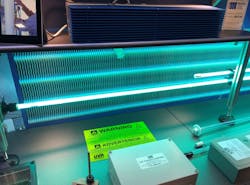Use UV to Clean Coils and Cut Energy Spending (AHR Expo)
Common ROI is six months, better IAQ, won’t have to pay maintenance staff to come in during non-business hours to clean the coils, reduce energy spending — these are just a few reasons why you should consider using UV.
Christoph: Hello, everyone. Christoph Trappe here, chief content engagement director with BUILDINGS.com. We’re still at AHR Expo and checking in with Dan Jones. He’s the president at UV Resources. Dan, thank you for joining us.
Dan: Thank you for having me.
Christoph: So, as you know, we’re just having meetings, lots of discussions, seeing what’s going on, what’s new in the industry, what’s important to building owners and facility managers.
And Dan struck up some interest here, talking about UV and keeping clean, being more efficient, saving money, which of course anybody likes to do that. So, tell me about some of the things that are of importance here.
Dan: Yeah, so our typical application for UV is down streaming the cooling coil to keep it clean and efficient. And what we’re doing down there is a germicidal light is actually killing mold and bacteria on that coil, deep into the depths of that coil.
BUILDINGS Podcast
Rather listen to the podcast?
Christoph Trappe and Dan Jones, president of UV Resources, chat about the benefits of using UV to clean coils.
These can include better IAQ, less spending on energy costs and sometimes an ROI of six months.
What happens when a coil gets fouled is you get an increase in pressure drop; you also get leaving air wet bulb temperatures that start to rise. So, people in the space become uncomfortable, they feel sticking because it’s not removing water.
UV actually goes into the air handler and will kill that mold and bacteria very quickly. And actually, over time as it digs deeper down into that coil and that wet bulb temperature starts to go down, pressure drop goes, and you have comfortable tenants. You don’t have to worry about cleaning your coils anymore.
Christoph: So, obviously you have to clean things anyways.
Dan: Right. You’re already - maintenance guys typically wanna get in there and clean their coils. Sometimes they can do it during work hours, but a lot of times they have to do it over the weekend, which is, you know, you’re going to pay extra for a guy to come in and clean the coil. And cleaning a coil with, say pressure washing is not really that effective. They can’t get into the depths of the coil.
[More from AHR Expo: Ever-changing Environment of Facility Management]
So, the UV is going to be on 24/7, 365, keeping that coil clean.
Christoph: It happens automagically.
Dan: Automagically.
Christoph: You guys know…
Dan: We’ll have to trademark that. Automagically.
Christoph: I use it all the time already, Dan. Too late on that one. But as you guys know, if you’ve listened to any other shows, we like anything that’s automagic for sure.
What’s the story of the company?
Dan: Well, we started back in 2005. We were at other companies doing similar things and I partnered up with two guys that were working with me and we started the company with the idea of our goal is to try to bring UV to every application.
Our thinking, UV should be on every cooling coil out in the United States and around the world. Because both the health side of it, you’re going to get better indoor air quality, but also the energy side of it, and everybody can benefit from it.
A typical install could be about 15 cents per CFM, and that’s an installed price of UV. And for that, you get a return on investment probably under six months.
(Photo: Best known for its groundbreaking UV technology designed for HVACR equipment and applications, UV Resources has expanded its UV-C product offering to address emerging infection control applications with the new upper air UV fixture. Credit: UV Resources)
Christoph: Six months. Unbelievable.
Dan: Yeah. It is. People don’t believe it until they see it. And the idea of putting a UV lamp downstream of a coil is going to save me energy, it’s kind of a tough concept to grasp. But when you see it happen, when you read these case studies of these guys that are saving incredible amounts of money, it definitely convinces you.
Christoph: So, at what stage would a facility manager or building owner, probably a building owner I would think, consider this technology? What are they thinking about when they’re thinking about it?
Dan: Yeah. If it’s a new construction building or you’re getting a new air handler in and you have UV at the beginning, you’re never going to have an issue as far as coil cleanliness. But for a building owner that has older air handlers, that performance is definitely degraded in them, that’s just a natural process. Putting UV on can actually bring those back.
We’ve had case studies where guys have put UV on, and they were planning on replacing this equipment and were able to push that out another five years because of the recovery of the performance of the coil they were able to get with UV.
Christoph: What are some of the barriers for implementation? Or the market penetration?
Help BUILDINGS Shape 2019!
What BUILDINGS resources are most valuable to you? What would you like to see us provide?
Please take our short (under 2 minutes) survey - just 5 short questions.
Thank you!
Dan: Well, for us it’s really education. Because if a guy knows about it or a person knows about UV and what it can do, it all comes down to the education. Because once they know about it, and they see it work, that’s it. So, that’s basically the only barrier.
The other challenge could be just different air handlers and how they’re built and applying the UV different ways. Some air handlers you can’t get into. So, we have a product that mounts from the outside and sticks into it.
Other air handlers are big. You can walk into the (unintelligible) and set things up. And that way we have an application for that as well.
Christoph: Great. Fantastic. Thanks for joining us, Dan. That was Dan Jones, president of UV Resources. Still reporting here from the AHR Expo in Atlanta, with another episode of the BUILDINGS Podcast.
More AHR Expo Coverage:
About the Author

Christoph Trappe
Former Chief Content Officer
Christoph Trappe, a top 25 content marketer and author, was the former chief content officer at Stamats Communications, the parent company of BUILDINGS.

